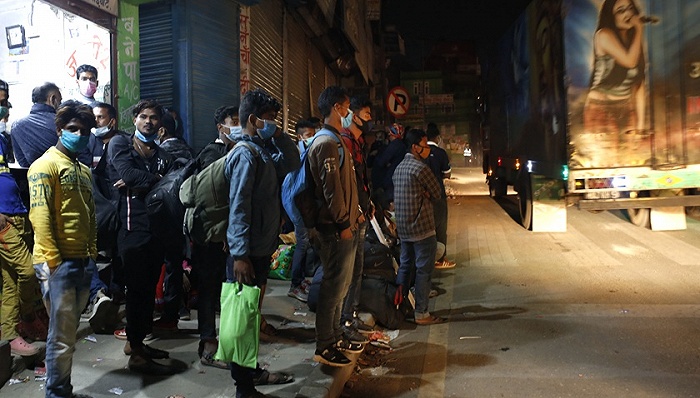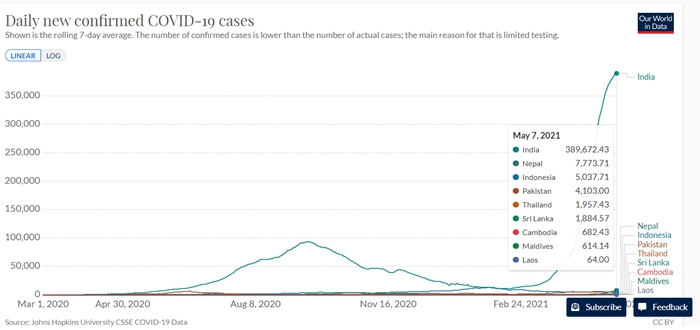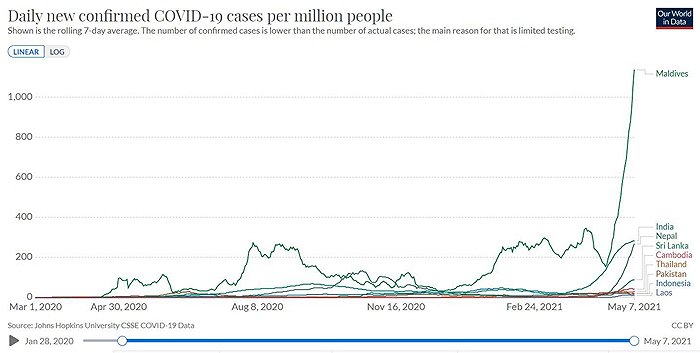
Reporter | An Jing
Nepal, Maldives, Sri Lanka, Pakistan, Laos, when India's new corona epidemic continues, many Southeast Asian and South Asian countries are also experiencing a new round of epidemic shocks.
In Nepal, which borders India, the number of newly diagnosed cases in a single day has soared from hundreds of cases in April to the current 9,000 cases. With a shortage of beds and medical equipment, there are concerns that Nepal is becoming the second India.
In the tourist resort of Maldives, the number of newly diagnosed cases per 1 million people in a single day in the Maldives, calculated according to the proportion of the population, even exceeds that of India, reaching 1,136.
However, not all the rises in new diagnoses in relevant countries are related to the Indian epidemic.
Beds in Nepal are in a hurry
On May 6, the number of newly diagnosed cases in Nepal reached a new high of 9,070; a month ago, on April 1, the country’s newly diagnosed cases were only 136.
According to Nepal’s official data, there are currently more than 3,500 deaths in the country, 400 of which occurred in the past two weeks.
An official from the Nepal Epidemiology and Disease Control Center stated that the country’s medical system is being severely hit by the new corona epidemic, and intensive care equipment and ventilators are facing shortages. Many hospitals in the capital Kathmandu warned that there are no extra beds to treat patients with the new crown, and there is a shortage of medical oxygen.

Earlier this week, Nepal’s Prime Minister Oli asked the international community for help, calling on countries to provide medical equipment and vaccines to help Nepal control the epidemic.
Compared with India, where public healthcare has been underinvested all the year round, the situation in Nepal is worse. The country has a population of approximately 30 million, but only has 1,595 intensive care beds and 480 ventilators, and the number of doctors per 100,000 people is only 0.7.
In order to increase the number of beds, the Nepalese government has asked military hospitals, university hospitals and private hospitals to admit patients with the new corona; in order to solve the problem of insufficient oxygen cylinders, the authorities plan to import from China.
Nepal’s vaccination plan started in January this year, but because the country’s vaccines are mainly from India, vaccination was suspended after India stopped exporting. China has donated 800,000 doses of vaccines to Nepal, and Nepal is currently considering importing Russian vaccines.
According to media reports, the epidemic in Nepal has spread to Mount Everest, and at least 17 climbers in the Everest base camp have been diagnosed with the infection. However, Nepalese officials denied relevant reports on Friday, saying that there was no health crisis among the mountaineering team.
In 2019, climbing Everest brought about 300 million U.S. dollars in income to Nepal. Tourism contributes 8% of Nepal’s GDP.
Frequent exchanges with India, political gatherings, religious festival gatherings and other factors have combined to exacerbate the epidemic in Nepal. The border between Nepal and India is 1,850 kilometers long, and the people of the two countries have close contacts.
During the "Great Pot Festival", a super-spreading event in India, a large number of Nepalese people also participated in it, including the former King Gyanendra and his wife of Nepal. The former kings and his wife have been diagnosed with the new crown.
At the same time, after the epidemic in India worsened, a large number of Nepalese people working in India returned to the country. However, Nepal’s isolation and virus testing conditions were limited, and the virus spread in Nepal with the movement of people.
In addition, due to restrictions on travel in India, some Indian tourists use Kathmandu, the capital of Nepal, as a transit point, and fly from Kathmandu to other countries to avoid the epidemic.
Last week, Nepal announced that it would ban Indian passengers from transiting in Kathmandu.
Maldives diagnoses surged
On April 23, the number of new diagnoses in a single day in the Maldives remained below 200; by Friday, the number of new diagnoses in a single day had risen to 766. As of Friday, the Maldives had a total of more than 34,000 confirmed cases, and the total number of deaths remained below 100.
According to statistics from the University of Oxford, according to population proportions, the Maldives has an average of 1,056 newly diagnosed cases per 1 million people in a single day in seven days, surpassing India’s 282 cases and Nepal’s 250 cases, the highest among all countries.

This week, the Maldives has announced a curfew and restrictions on travel between the islands, but foreign tourists can still go to private islands after showing a negative certificate for the new crown test.
When the epidemic in India worsened, the Maldives became a popular refuge for the rich and middle class in India. The record of tracking private aviation data agency WingX shows that private flights to and from the Maldives have increased by 360% this year.
From January to March, about 70,000 Indian tourists traveled to the Maldives, twice the number of the whole year in 2020. At a time when a large number of Indian tourists came in, the Maldives held local elections and various religious gatherings during Ramadan, and the capital Male became the hardest hit area of the epidemic.
The Maldives previously planned to launch a new crown vaccine tour to provide foreign tourists with vaccination services after completing the vaccination of its citizens. Now, before the economy can be recovered through vaccine tourism, the Maldives needs to control the domestic epidemic first.
In addition to Nepal and the Maldives, Sri Lanka, Cambodia, Pakistan, Indonesia, and Laos have all seen an increase in new diagnoses recently.
Among them, the number of newly diagnosed cases in Sri Lanka has risen sharply in a single day since mid-April, from 300 cases to about 1,900 cases.
However, the Sri Lankan authorities said that the increase in the number of new confirmed cases has nothing to do with the Indian epidemic, mainly because the people held large-scale celebrations for the Sri Lankan New Year that began on April 13.
According to the surveillance in Sri Lanka, the country has not reported the mutated virus found in India. The spread of the epidemic is mainly due to the spread of the mutated virus found in the UK.
Indonesia and Pakistan regard religious activities and gatherings during Ramadan as the main reason for the increase in new diagnoses. Indonesia first reported the mutant virus discovered in India this week, and Pakistan entered a 10-day lockdown starting Saturday.
Laos has imposed a two-week blockade on 15 provinces since the end of last month, and Cambodia just ended the blockade this week. Laos attributed the increase in new diagnoses to the spread of the imported virus from Thailand, while Cambodia believed that the spread of the mutant virus found in the UK was the main reason for the spread of the epidemic.












